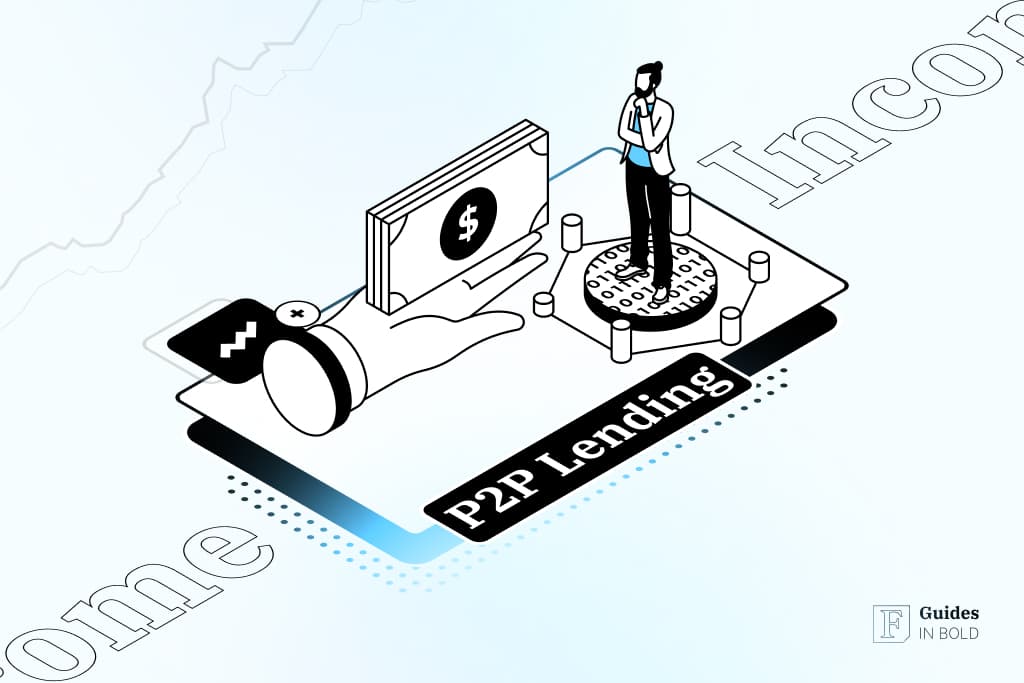Peer-to-peer (P2P) lending is an investment strategy that involves lending money directly to individual borrowers without involving third-party intermediaries such as banks. By engaging in P2P lending, you can generate passive income from interest payments while diversifying risk across multiple loans, which makes it an appealing option for those seeking steady income.
What is P2P lending?
While P2P lending has been around for centuries, the internet has revolutionized the process by enabling online transactions through dedicated platforms such as the Loanch P2P lending platform.
This approach offers several advantages for both lenders and borrowers, as loans are processed faster, more conveniently, and transparently online. Additionally, competition between investors on P2P platforms often drives interest rates down, as there is no fixed rate.
Another notable feature of P2P lending is risk mitigation. Namely, since multiple creditors can invest in a single loan, individual losses in the event of borrower insolvency are reduced.
Passive income with P2P lending
P2P lending can help generate passive income in several ways.
Most notably, lenders earn passive income through the interest borrowers pay when returning the loans. The amount of interest depends on factors like loan size, interest rate, borrower reliability, and P2P loan platform.
What is especially important is that once loans are funded, the P2P platform itself handles everything from payment collection to interest distribution. This allows lenders to earn without actively managing their investments.
What’s more, many P2P platforms offer auto-invest features, distributing funds to new loans based on lender criteria. This eliminates the need for manual investment decisions.
Further, lenders can reinvest borrower repayments (often automatically). This expands loan portfolios and increases potential interest income so that continuous reinvestment can compound earnings over time.
Finally, P2P lending returns are often less correlated with traditional financial markets like stocks and bonds. This can help diversify your investment portfolio and lower overall risk. Given the inherent volatility of assets such as stocks and bonds, P2P lending offers a comparatively safer option for those seeking to earn passive income.
How to make passive income with P2P lending?
To start with P2P lending, it’s important to choose a platform that aligns with your investment goals. Look for platforms with a strong reputation, transparent fees, and a proven track record of successful loans, and be sure to understand your local lending regulations to ensure they align with the platform’s policies.
P2P lending platforms generally have low minimum investment requirements, which makes them accessible even to investors with a smaller budget. This allows almost anyone to participate in passive income generation.
Our recommended P2P lending platform is Loanch, a financial platform that allows investors to invest in loans and gain interest payments over time. Launch comes with features such as:
- 30-days buyback obligation;
- 13.6% interest rate;
- Auto investing.
As a P2P lender, you have to assess loan listings on your trading platform. These listings include details about borrowers, loan purposes, interest rates, and risk levels. To ensure profits, you have to evaluate each listing based on your investment preferences and risk tolerance.
Equally as important is active portfolio management. That is, be sure to track repayment schedules, interest earned, and any late payments or defaults. Fortunately, some platforms, such as Loanch, offer automated reinvestment options, which allow you to reinvest repayments into new loans to maximize returns.
Investing and reinvesting
While some lenders may opt to withdraw funds short-term, this approach is not ideal if you’re looking for passive income. A more effective strategy is to reinvest the funds. By lending the money you earn to borrowers again, you can accumulate interest over time. With automated reinvesting, you can ensure that your earnings are continuously reinvested into new projects without actively monitoring them.
Another helpful strategy is to collaborate with other investors on the platform. While lending to individual borrowers is easily manageable, larger loans often require greater investment capital and more active participation in the process. To address these issues and ensure you don’t have to actively track every loan, you can join investment pools.
Diversifying your portfolio
One common mistake investors make is placing all their funds in a single asset. While a well-performing investment can yield high returns, it can also result in irreparable losses if you do not hedge against potential market downturns by investing in other assets.
Equally important is portfolio rebalancing. Fortunately, P2P lending allows for regular adjustments, and reviewing and updating your portfolio based on past performance will help you optimize returns and minimize risks.
Pros and cons of P2P lending

Pros
- Low entry points: Most P2P lending platforms have relatively low minimum investment requirements;
- Less correlation to traditional markets: P2P lending returns are often less tied to fluctuations in the stock and bond markets;
- Automation: Many P2P platforms offer auto-investment tools;
- Diversification: You can invest in loans to diversify your portfolio;
- User control: P2P platforms allow you to choose which loans to fund based on your risk tolerance.

Cons
- Risk of default: Borrowers may fail to repay their loans, leading to potential losses;
- Lack of liquidity: While some platforms offer secondary markets for selling loans, liquidity is not guaranteed, meaning you cannot back out of the investment as easily;
- Less regulated: P2P lending is not as tightly regulated as traditional investments.
Conclusion
In conclusion, P2P lending can be a solid way to generate passive income, allowing lenders to earn interest from loans without the need to involve third parties such as banks and actively manage their investments. Using automated investment tools, reinvesting your earnings, and diversifying your portfolio, you can create a steady and growing income stream.
While P2P lending carries certain risks, careful platform selection and ongoing portfolio monitoring can help mitigate them. For those seeking an alternative investment strategy, P2P lending can provide competitive returns with a relatively low entry point.
Disclaimer: The content on this site should not be considered investment advice. Investing is speculative. When investing, your capital is at risk.
FAQs about P2P lending
How much can you earn with P2P lending?
P2P lending can lead to profits, but returns will vary depending on location and jurisdiction. Typically, investors can expect annual returns ranging from 5% to 10% on online investing platforms.
Is P2P good for passive income?
Yes, P2P lending can be a good source of passive income, but the profits will depend on factors such as your risk tolerance, diversification strategy, and the platform you choose
Is P2P lending legal?
Yes, P2P lending is legal in most countries, but it is subject to varying regulations depending on the jurisdiction.
How safe is P2P lending?
P2P lending involves some financial risk, as returns are not guaranteed due to borrower default issues. However, thereare no market-related risks associated with P2P lending, meaning the value of your investments will not fluctuate as quickly as, say, stocks.
How does P2P lending work?
In P2P lending, borrowers submit loan applications to P2P investment platforms. Lenders then review the applications and choose to fund portions of the loan. When the loan is fully funded, the borrower receives the money and repays it in monthly installments, including interest. The platform distributes these payments to the lenders, providing them with a return on their investment through the interest earned.




